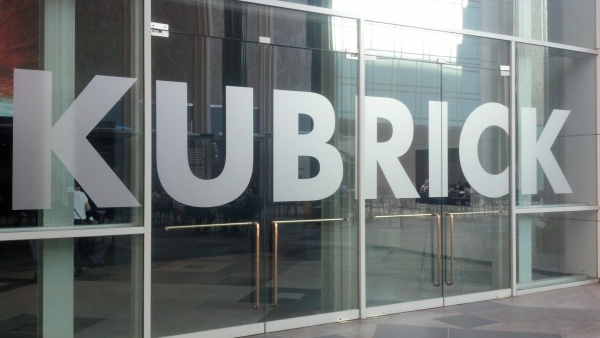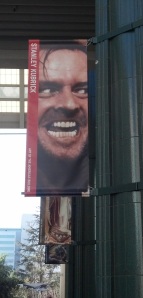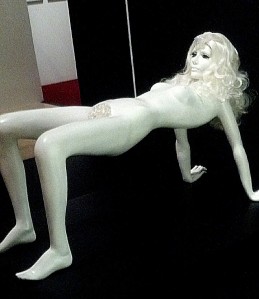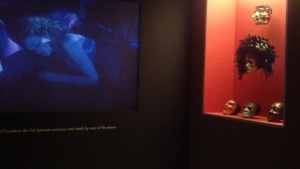The Stanley Kubrick Exhibit is a Treat for Fans
The extensive Stanley Kubrick exhibit at the Los Angeles County Museum of Art opens to the public on November 1st, but I had the sincere pleasure of visiting the show a little early. As a LACMA member, I enjoyed a relatively uncrowded stroll through the museum’s presentation of Kubrick’s career in film. This is the first showing of the exhibit in the United States and I’m thrilled that Los Angeles is its first stop.
Kubrick has long been one of my favorite filmmakers (perhaps my absolute favorite if you pressed me to choose). His distinct vision and obvious obsession with perfection led to countless unforgettable film moments over the course of only a handful of projects. Each of his movies are given some time and space at the show, though obviously his more recognizable and important works take up the most real estate in the museum. In addition to myriad costumes, props, photos, scripts, letters, notes, and equipment, multiple screens are set up throughout the museum that offer various clips from his films and interviews about his work.
Kubrick was quite dismissive of his first film, Fear and Desire, as well as his follow up, Killer’s Kiss, so these are given relatively little attention with only a few photographs and some notes, although themes from both films would carry over into his later career. Where the showcase really kicks into gear is with the director’s first classic, The Killing. Starting with that film from 1956, the exhibit forms something of a maze, leading patrons through a chronological journey of Kubrick’s films, each given its own personalized section of viewing space. The following is a short breakdown of the man’s decades of cinematic work that’s offered up at the Los Angeles County Museum of Art:
The Paths of Glory section of the show gives a look at the technical mastery it took create the groundbreaking trench sequences during the film’s battle scenes. Lolita‘s section is filled with quasi-voyeuristic photos of the cast, most prominently the film’s lead, Sue Lyons, as well as personalized letters to Kubrick from Christian activists who were horrified to hear of the film production. Hilarious. The infamous/hilarious original ending to Dr. Strangelove– a pie fight in the War Room– is shown in photographs, as well as tributes to the film’s co-writer, Terry Southern, and the scene-stealing Peter Sellers.
A significant amount of time and space was dedicated to what many consider Kubrick’s ultimate masterpiece, 2001: A Space Odyssey. Among the artifacts are ape and space costumes worn by actors in the film, an amazing model of one of the most famous set pieces, and a great deal of original concept art that helped the special effects eventually come to life.
Kubrick’s other science fiction masterpiece, A Clockwork Orange, is arguably my favorite of his films. This corner of the exhibit is probably the most fun, which I have a feeling is on purpose considering the film’s wry sense of humor. Alex’s famous white costume and black derby hat is on display here, as well as very impressive models of the female sculptures from the Korova Milk Bar.
The Barry Lyndon section offers a look at the director’s keen eye for details. The ornate costumes for the film are on display, as are copious notes and research about the time period. Accompanying this section is a rarely seen glimpse at Kubrick’s passion to make a film about Napoleon. A great deal of time and expense went into a film that was never made, though he accumulated a small library about the conqueror’s life and produced a massive card catalog that documented every aspect of Napoleon’s time.
The Shining competes for the top-spot in my list of Kubrick faves and it was a thrill to see the amount of script notes, marketing art, set photos, and one-of-a-kind props on display. Two of the film’s prop axes stick out of the museum’s wall, Wendy’s knife and Jack’s typewriter sit side-by-side, and the twins’ creepy little dresses threaten to start moving and call you to come play. A model of the famous hedge maze is eerie to see, particularly when the film’s music can be heard playing in the background.
The painstaking work to achieve an authentic Vietnam experience is on full display in the Full Metal Jacket section of the exhibit. A remarkable amount intimate behind-the-scenes photos show the amazing breadth of the film’s production design. Various versions of the screenplay with Kubrick’s editorial red ink covering them gives an idea of just how many changes the film went through both before and during production. Most striking, however, is probably Private Joker’s iconic “Born to Kill” combat helmet hanging on the wall. It is truly surreal to see in person.
The director’s final film, Eyes Wide Shut, is sadly a bit underrepresented, but the limited set photos and costumes are terrific. Some of the actual masquerade costumes are on display and the film’s haunting, simple score in the background adds an aura of impending dread. Other pieces of unfinished work, such as his vision of a World War II film called The Aryan Papers or his extensive work on A.I.: Artificial Intelligence before Steven Spielberg eventually took over directing, are explored with extensive photography and notes. A handful of his early journalistic photos offer some insight into a young Kubrick’s immense talent from an early age.
I spent nearly two hours working my way through the museum’s sprawling exhibit and I left feeling completely satisfied. I’ve been anticipating the opening of this show for a long while now and I’m very happy to say that it is a success. It will be running through June, so be sure to make time to go to LACMA if you’re anywhere near the Los Angeles area and if you’re the slightest fan of Stanley Kubrick. Even if you only like one or two of his films, it will be well worth your while.
Archives
Tags
1970s 2012 Academy Awards Academy Awards action actor A Dangerous Method addiction A History of Violence AMPAS Antichrist Antonio Banderas Aurora blog Brad Pitt Bret Easton Ellis Chris Pine comedy Cosmopolis David Cronenberg Dead Ringers Devin Marble Django Unchained Eastern Promises expressionism Ezra Miller Fassbender favorite films film German film horror Jack Nicholson James Deen John Landis Jose Padilha LACMA Leonardo DiCaprio Lindsay Lohan Martin Scorsese McQueen Michael Fassbender Midnight in Paris movies MPAA Neil Jordan Oscars Paul Schrader Paul Thomas Anderson Planet of the Apes Psycho Quentin Tarantino remake Robert Pattinson RoboCop Sean Penn sex Shame shooting shortcuts Stanley Kubrick Stephen Rea surreal surrealism Tarantino The Cabinet of Dr. Caligari The Canyons The Godfather The Master The Shining thriller Tilda Swinton Twilight Videodrome violence We Need to Talk About Kevin Woody AllenTop Clicks
- None




